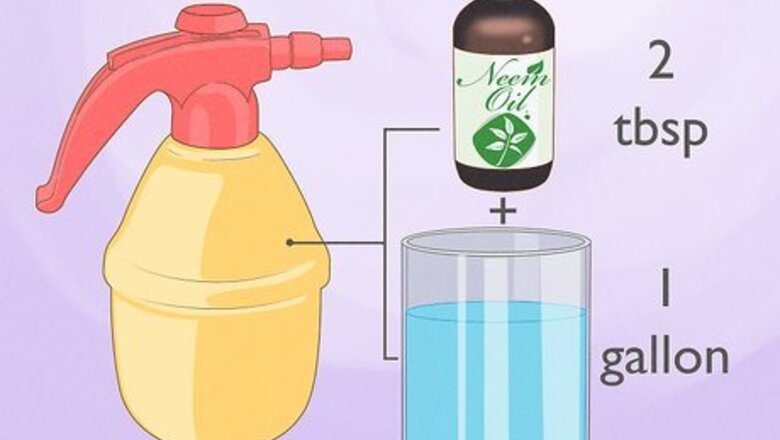
views
- Apply 70% isopropyl alcohol directly to mealybugs using a cotton swab to kill them on contact. Check and reapply the alcohol once a week until the bugs are gone.
- Dilute neem oil in water following the manufacturer’s instructions and spray it directly onto the plants. Spray your plants weekly until the mealybugs disappear.
- Spray your plants with organic insecticides once or twice a week following the directions on the package to eliminate the infestation.
Neem Oil

Mix together water and neem oil in a spray bottle. Neem oil is a natural insecticide that comes from neem trees that helps control small insects like mealybugs. Add about 2 tablespoons (30 ml) of the neem oil into a large spray bottle or garden sprayer. Pour in 1 gallon (3.8 L) of water and thoroughly stir the mixture together until it’s thoroughly combined. Read the manufacturer’s instructions on your neem oil. Some may be mixed at a different concentration or require no mixing at all. Try adding a 2 tablespoons (30 ml) of dish soap with the neem oil and water to help the spray stick to the plant leaves better. Avoid using any higher concentrations of soap, however, since they could burn your plant’s leaves.

Spray the plant you’re treating until it’s completely covered. Apply the neem oil spray evenly over all of the plant’s surfaces, such as underneath the leaves, at the base of the branches, and over the top of the soil the plant is in. Try to completely smother all the visible mealybugs with the neem oil mixture. Neem oil is thick enough that the mealybugs can’t breathe when they’re coated in it.

Move the plant to a shaded area to dry. If you’re spraying a potted plant, keep the plant out of direct sunlight or extreme heat so the foliage doesn’t burn or get sun-damaged. If you’re spraying outdoor plants that are rooted in the ground, wait for a shady day when it’s below 85 °F (29 °C) outside to prevent damage.
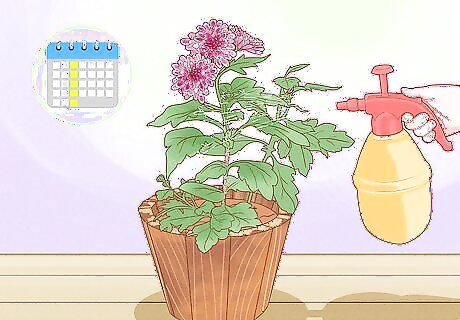
Spray the plant weekly until the mealybugs are gone. One application of neem oil probably won’t kill all the mealybugs on the plant. Because mealybugs have a rapid lifecycle, continue applying the neem oil mixture each week to routinely kill the newly-hatched bugs. Keep inspecting your plant and applying the neem oil until all of the mealybugs have been killed off. If the plant looks green and full, and you don't see anymore mealybugs on it, they're most likely gone.
Insecticides

Prune off any infested branches before applying an insecticide. Look for infested branches that have a waxy, white coating on them or that have yellowed or withered leaves. Use pruning shears to cut the branches off at the base. Cutting off the most infected branches helps get rid of some of the mealybugs and makes the insecticide more effective because there will be fewer places for the bugs to take shelter. If your entire plant is covered with mealybugs, then it may be difficult to control the infestation. It may be better to get rid of the plant completely rather than trying to kill all the bugs.

Use an organic insecticide that's designed for ornamental plants. Insecticides made for ornamental plants are less likely to cause damage to your plant’s leaves while still getting rid of the mealybugs. Alternatively, use an insecticidal soap, which naturally washes away and kills pests. Check the label on the insecticide to make sure it’s labeled as safe for decorative or ornamental plants. Switch to a chemical pesticide if you have a heavy infestation. Some ornamental insecticides you could use to kill mealybugs are acephate, malathion, carbaryl, and diazinon. If you want to make your own insecticide, finely mince 10–15 cloves of garlic and add them to 1 US pint (470 ml) of mineral oil. After 24 hours, strain out the garlic pieces and add the mineral oil to ⁄2 gallon (1,900 ml) of water.

Spray the plant with the insecticide until it's soaked. Use the spray bottle that the insecticide came in or dilute it in a garden sprayer following the manufacturer’s instructions. Coat the leaves and branches of the plant with insecticide so they’re thoroughly covered. Make sure you get underneath the leaves and at the base of the branches on the plant as well since mealybugs tend to gather there.

Do regular insecticide applications until the mealybugs are all killed. It may take more than one application to remove all the mealybugs on the plant, so follow the manufacturer’s instructions for how often to reapply. Typically, you’ll spray the plants 1–2 times a week, but it may vary on the insecticide you’re using. If the plant is thriving and you can't see any more mealybugs on it, then stop spraying insecticide.
Rubbing Alcohol

Remove any mealybugs you see on the plant. Mealybugs look like small, fuzzy white bugs with a waxy coating. They usually gather in large groups on the undersides of leaves or in crevices along the stems. If you see any stray mealybugs, pick them off by hand and dispose of them in the trash. Mealybugs don't bite, so it’s okay to handle them with your bare hands. If you’d rather avoid touching them directly and getting the waxy coating on your fingers, put on a pair of gardening gloves. Removing as many mealybugs by hand first is best since it doesn’t require applying anything to your plants. It also helps you use less alcohol later on.
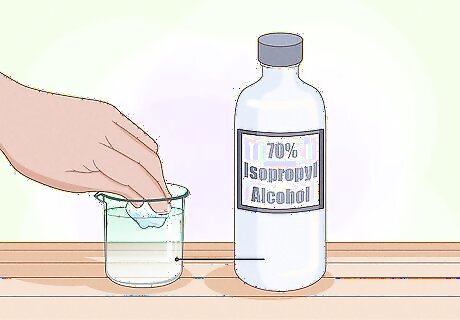
Dip a cotton swab in 70% isopropyl alcohol. Any isopropyl alcohol (rubbing alcohol) with a 70% or lower concentration works well to kill mealybugs instantly on contact. Wet the end of a cotton swab with the alcohol until it’s dripping wet. Isopropyl alcohol may damage plants with soft or sensitive leaves. Test the alcohol on a small leaf and let it sit for a day or two. If the leaf withers or gets discolored, then avoid using alcohol. Avoid using alcohol with a higher concentration because it could damage or burn your plant’s leaves.

Rub the cotton swab over the surface of the infested plant. Look for areas where the mealybugs are gathered between leaves and along the stem. Wipe the cotton swab over the mealybugs to get rid of them. Make sure you get underneath the leaves and inside the crevices on the branches as well. Using a cotton swab works best if you’re managing a small, early infestation of mealybugs.

Use a spray bottle to coat large plants with rubbing alcohol. Fill up an empty spray bottle with your rubbing alcohol so it’s easier to apply to larger leaves and infestations. Be sure to spritz the solution all over the surfaces that are infested with mealybugs. Focus your spray on the undersides of the leaves where mealybugs tend to gather.

Apply alcohol weekly until the mealybugs are gone. Because mealybugs hide in hard-to-reach places, your first application may not kill the entire infestation. Even if you don't see any more mealybugs, continue rubbing or spraying your plant with isopropyl alcohol for about 2–3 weeks. That way, you’ll continue getting rid of mealybugs through all stages of their life cycle. When you can't see any more mealybugs on the plant and the foliage remains healthy and green, then the infestation is completely gone. If you have a heavy infestation that doesn’t go away or has overtaken your plant, dispose of the plant instead to prevent the mealybugs from spreading.
Preventing Mealybugs
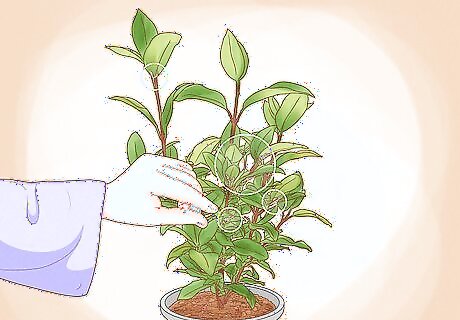
Inspect new plants for mealybugs before introducing them to your garden. Any time you bring a new plant home, check the branches and leaves for small, round, white insects that are covered in a waxy substance. If you find mealybugs on a new plant, pick them off and dispose of them right away so they don’t spread. If you notice a lot of mealybugs infesting multiple branches of the plant, you may need to throw it away or return it to where you bought it. Never introduce a mealybug-infested plant to your garden or the infestation can quickly spread to your other plants.

Spray plants with high-pressure water twice a week. Use a high-pressure hose attachment or a pressure washer with a broad tip if you have mealybugs on plants with strong, sturdy leaves. Turn the water on and spray your plant’s leaves to wash away any mealybugs that are on the surface. Avoid using a pinpoint tip on your hose or pressure washer since it could cut through or damage the foliage. If your plant has leaves that are fragile or tear easily, then avoid using a high-pressure wash since you could damage the foliage. Instead, try wiping on a leaf shine spray that contains neem oil to help prevent mealybugs.
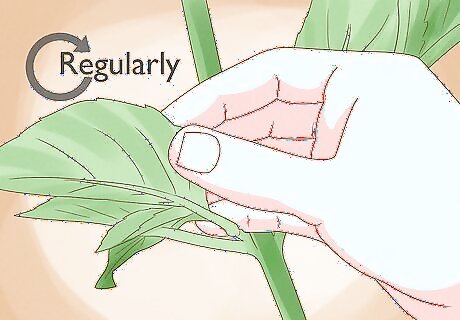
Check your plants for mealybugs regularly. Make it a part of your plant’s regular care routine to check the base of the stem and between the leaves for mealybugs. If you discover mealybugs on one of your plants, pick them off by hand and toss them in the trash to stop them from spreading. If the plant is heavily infested, remove it from your garden immediately so the infestation doesn’t spread. It’s a lot easier to treat a mealybug infestation when you catch it early because there are fewer bugs to deal with.

Clean or throw away garden tools that are infested with mealybugs. Mealybugs can gather on garden tools like shovels, plant clips, and pots. Before you use your tools, always check them for mealybugs, especially near cracks and crevices where they may gather. If you find any bugs, disinfect your tools to get rid of them. If you still can’t treat all of the mealybugs on your tools, then toss them out and get new ones. Make it a habit to clean and disinfect your tools after each use so they’re less likely to get infested.

Attract beneficial insects to your yard for a natural solution. Mealybugs have natural predators like ladybugs, lacewings, and parasitic wasps. These bugs mainly feed on nectar or pollen, so plant bright, fragrant flowers in your garden to help attract them to your yard. Try to avoid using commercial insecticides if you can so you don’t accidentally kill the beneficial bugs.
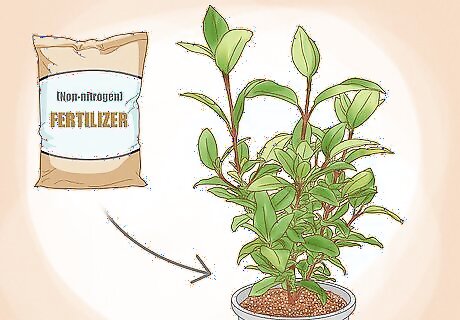
Avoid fertilizing your plants with nitrogen if possible. High levels of nitrogen can cause mealybugs to reproduce faster. If your plants don't need to feed your plant, use a non-nitrogen fertilizer to prevent mealybug infestations from growing or getting worse.




















Comments
0 comment